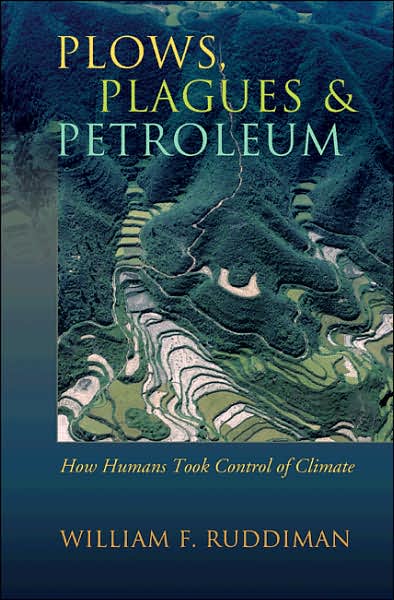

| PLOWS, PLAGUES, AND PETROLEUM How Humans Took Control of Climate William F. Ruddiman Princeton: Princeton University Press, 2005 |
Rating: 5.0 High |
|||
| ISBN-13 978-0-691-12164-2 | ||||
| ISBN-10 0-691-12164-8 | 202pp. | HC/GSI | $69.90 | |
I don't think there is a more objective book on climate change than this one. William Ruddiman recently retired from the University of Virginia, where he was Professor of Environmental Sciences. Before that he was a Doherty Senior Research Scientist at Columbia University's Lamont-Doherty Earth Observatory. He is the author of numerous scientific papers and a textbook, Earth's Climate: Past and Future.
Dr. Ruddiman formulated the hypothesis that human activities affected Earth's climate long before the start of the industrial age. Here he documents the work he did to test that hypothesis. He assembles the evidence in sequential fashion through sixteen chapters, overcoming various challenges and building a convincing case.
Briefly, his hypothesis is that about 8,000 years ago, humans began to introduce extra greenhouse gases into the atmosphere. By cutting down trees and burning the wood to clear land for crops, they gradually raised the concentration of carbon dioxide. Irrigation, especially of rice paddies, produced a similar slow increase in methane.
If not for this inadvertent intervention, ice sheets would have begun creeping outward from northeast Canada. This was because the planet had entered a natural cooling phase. The various perturbations of its orbit resulted in a decline of sunlight received from its peak value.
There is another complexity. The traces of greenhouse-gas concentrations through time have "wiggles" — jumps of a few percentage points over periods from a decade to generations in length. These puzzled Ruddiman until he thought to correlate them with historical annals of pandemics in ancient texts such as the Domesday Book (1086). It then became clear that plagues such as the Black Death in medieval Europe, or the near extinction of Native Americans, corresponded to drops in CO2 and methane as nature reclaimed cleared land.
Like other scientists living in the real world, Dr. Ruddiman has noticed the distortions of science happening lately in politics and the media, often motivated by special interests.
"Probably as a result of my long interest in Earth's climate history, my own concerns about the future tend to focus on a related set of longer-term problems—"gifts" that nature has provided us through slow-acting processes that took place well back in Earth's past and that cannot be replaced once they are consumed."
"My concern about these gifts is simple: When these resources run low or run out, how will we find comparably inexpensive replacements? Like many people at retirement age, my personal concerns extend out to the life spans of my grandchildren. By the time they reach "old age," around the year 2075, I suspect it will be clear to all that some of the "free" gifts from Nature were not an unlimited resource. By then, I suspect that my grandchildren's generation will look back on the era between the late 1800s and the early part of the twenty-first century as a brief bubble of good fortune, a time when a lucky few human generations consumed most of these gifts, largely unaware of what they were doing." (p. 192)
"I know of no precedent in science for the kind of day-to-day onslaughts and perversions of basic science now occurring in newsletters and Web sites from interest groups. These attacks have more in common with the seamier aspects of politics than with the normal methods of science. Both the environmental and (especially) the industry extremists should leave the scientific process alone." – Page 189 |
The book's 18 chapters are divided into five parts, plus an Epilogue. The last two chapters are editorial in nature. Chapter 18 deals with the contending factions currently locked in a political tussle: extreme environmentalists on the one hand, extreme industrialists on the other. In Chapter 19, Dr. Ruddiman prognosticates on what the future activities of mankind may do to Earth's climate. These concluding chapters, part of the Epilogue, are followed by a chapter by chapter bibliography,1 a list of figure credits, and an index. The text is well supplemented by plenty of data plots, maps, and a few tables.

 To contact Chris Winter, send email to this address.
To contact Chris Winter, send email to this address.